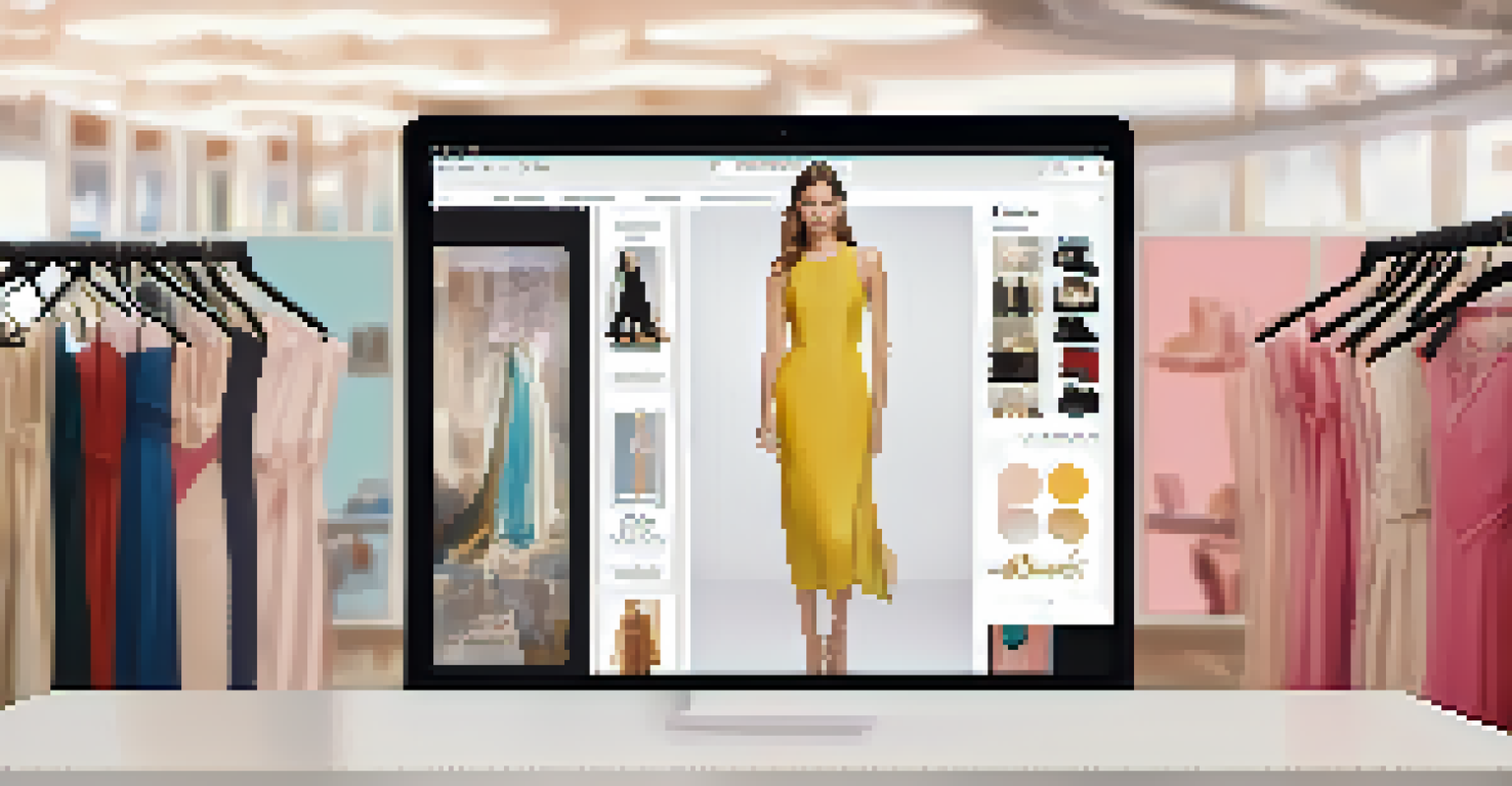The Emergence of Virtual Try-Ons in Fashion E-Commerce

What Are Virtual Try-Ons and How Do They Work?
Virtual try-ons are innovative tools that allow customers to visualize clothing and accessories on themselves without physically trying them on. This technology typically uses augmented reality (AR) to overlay a digital image of the product onto a user’s webcam feed. By simply using a smartphone or computer, shoppers can see how various styles and colors look on them in real time.
The future of retail is not about the competition; it's about the customer experience.
This process not only enhances the online shopping experience but also reduces the uncertainty that often accompanies buying clothes online. With the ability to rotate, zoom in, and even change styles, customers can make more informed decisions. Such advancements mean that the fitting room is no longer confined to physical stores; it has moved right into our homes.
As technology has become more accessible, many fashion retailers are adopting these tools to stay competitive. Brands like ASOS and Zara are already using AR technology, allowing customers to try on outfits virtually. This shift is not just a trend; it’s quickly becoming a standard expectation among consumers.
The Benefits of Virtual Try-Ons for Shoppers
One of the primary benefits of virtual try-ons is convenience. Shoppers can try on clothes anytime, anywhere, without the hassle of long fitting room lines or crowded stores. This convenience is particularly appealing for busy individuals who may not have time to shop in traditional ways.

Moreover, virtual try-ons can significantly reduce the rate of returns, a common issue in online shopping. When customers can visualize how an item will look on them, they are less likely to make impulse purchases that don’t fit their style or body type. This not only saves time for the shopper but also reduces costs for retailers.
Virtual Try-Ons Enhance Shopping
Virtual try-ons use augmented reality to allow customers to visualize clothing and accessories on themselves, enhancing the online shopping experience.
Additionally, virtual try-ons can help foster a more personalized shopping experience. Many platforms allow users to input their measurements or choose from a range of body types, ensuring a better fit and appearance. This tailored approach leads to higher customer satisfaction and loyalty.
How Brands Are Implementing Virtual Try-On Technology
Brands are leveraging advanced technologies like AR and AI to bring virtual try-ons to life. For instance, companies are using 3D modeling to create realistic representations of their products. This means that when a customer tries on a virtual dress, they see a lifelike version that mimics fabric draping and movement.
Technology is best when it brings people together.
Some retailers have partnered with tech companies specializing in AR to enhance their platforms. By integrating these solutions into their websites and apps, they can provide a seamless experience for users. Examples include brands like Warby Parker, which allows customers to virtually try on glasses using their smartphone cameras.
Furthermore, social media platforms are also incorporating virtual try-on features, allowing users to try on products before visiting a brand’s website. This strategy not only drives traffic but also effectively engages a younger audience that thrives on visual content.
Challenges Facing Virtual Try-On Technology
Despite its many benefits, the adoption of virtual try-ons is not without challenges. One major hurdle is the technology's reliance on high-quality imaging and accurate sizing. If the virtual representation does not closely match reality, it can lead to customer disappointment and loss of trust in the brand.
Additionally, some consumers still prefer the tactile experience of trying on clothing in person. The feel of the fabric, the way it fits, and how it moves with the body can all influence a purchasing decision. Overcoming this sensory gap remains a challenge for brands relying solely on virtual try-on technology.
Convenience Reduces Return Rates
The convenience of virtual try-ons helps reduce return rates by allowing customers to make more informed purchasing decisions.
Moreover, data privacy concerns are also prevalent. As users upload their images or measurements, ensuring their privacy and data security becomes paramount. Brands must navigate these concerns carefully to maintain consumer trust while implementing cutting-edge technology.
The Future of Virtual Try-Ons in Fashion E-Commerce
Looking ahead, the future of virtual try-ons in fashion e-commerce appears promising. As technology continues to evolve, we can expect even more immersive and realistic experiences for shoppers. Innovations like AI-driven style recommendations and enhanced facial recognition could personalize the shopping journey further.
Moreover, the integration of virtual reality (VR) could also change the game. Imagine walking through a virtual store, trying on clothes as if you were in a physical shop, all from the comfort of your home. This kind of immersive shopping experience could redefine how consumers interact with fashion brands.
As consumers increasingly seek convenience and personalization, brands that embrace this technology will likely thrive. The fusion of fashion and technology is setting the stage for a more engaging and tailored shopping experience, making virtual try-ons a vital aspect of future retail strategies.
Consumer Perceptions of Virtual Try-Ons
Consumer perceptions of virtual try-ons are generally positive, especially among younger shoppers who are more tech-savvy. Many appreciate the convenience and the ability to visualize products without stepping into a store. This demographic often values experiences that blend technology with shopping, making virtual try-ons an attractive proposition.
However, there remains a segment of consumers who are skeptical about the accuracy and effectiveness of these tools. Some worry that the virtual representation might not match the actual product, leading to disappointment upon delivery. Educating consumers on how these technologies work can help alleviate some of these concerns.
Future of Fashion E-Commerce
The future of fashion e-commerce looks promising as technology evolves, leading to more immersive and personalized shopping experiences.
Overall, as awareness and familiarity with virtual try-ons grow, acceptance is likely to increase. Brands that invest in quality technology and education will see a positive shift in consumer attitudes, leading to higher engagement and sales.
Conclusion: The Impact of Virtual Try-Ons on Fashion E-Commerce
In conclusion, virtual try-ons are transforming the landscape of fashion e-commerce. They offer a unique solution to common shopping challenges, from sizing issues to the limitations of traditional fitting rooms. As technology becomes more refined, the seamless integration of virtual try-ons into the shopping experience will likely become the norm.
Retailers who embrace this trend not only meet consumer demands for convenience and personalization but also position themselves as innovators in a competitive market. It’s a win-win situation: customers enjoy a better shopping experience, while brands benefit from increased sales and customer loyalty.

As we move forward, it’s clear that virtual try-ons are more than just a passing fad; they represent the future of how we shop for fashion. By continuing to explore and expand these technologies, the fashion industry is poised for a significant evolution.